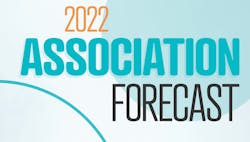2022 Association Forecast
As noted in the 2021 State of the Industry Report, 2021 was a year with many important events for the industry, from regulatory movements on the Lead & Copper Rule to the American Society of Civil Engineers Infrastructure Report Card and the months-long process surrounding the proposal, adoption, passage and signing of the Bipartisan Infrastructure Law. As the industry prepares for a new year with an historic swath of funding, Water & Wastes Digest reached out to even more associations than it ever has with the goal of providing a comprehensive view of the coming year from all angles.
Notably, these briefs all have a focus on the infrastructure funding headed to the industry in 2022 and the four years following it, but areas of interest also include recruiting and retention, supply chains, and the regulatory environments surrounding Buy America, the Lead and Copper Rule and the imminent rules regarding per- and polyflouroalkyl substances.
Funding the Future of Water Today
by Steve Dye, Legislative Director, Water Environment Federation
With the passage of the Infrastructure Investment and Jobs Act (IIJA) there is the exciting potential for making significant headway toward addressing areas of critical need for the water sector. These areas include:
- Making wastewater and storm water systems more resilient and capable of mitigating current and emerging issues through innovative technologies and policies;
- Protecting public health and the environment for all communities;
- Building a strong and diverse workforce for the future;
- Developing policies and practices that balance the need for infrastructure investments while not overburdening ratepayers, and
- Providing increased funding resources for needed infrastructure investments.
But in order to effectively leverage the IIJA to make progress in these areas, two key parts need to fall into place over the next year or two.
First and foremost, while the IIJA authorized and reauthorized a variety of significant and critically needed programs to fund water infrastructure, only the Clean Water and Drinking Water State Revolving Funds (SRF) received guaranteed funding at levels that will provide substantial resources to communities and utilities. This means that the other 20 or so new grant and policy programs in the IIJA will need funding in the fiscal year 2022 appropriations bill and subsequent appropriations bills. This is necessary for the programs to meet the aspirational goals set forth by Congress and provide desperately needed funding to communities nationwide. It will be critical that stakeholders, like WEF and our 30,000 members, push Congress to fund these important new programs.
The second major hurdle will be the complexities of standing-up these new grant and policy programs, followed by equitably and expeditiously getting the funding to communities and utilities. The expanded Buy America requirement is a good example of the complexity of the roll-out of the IIJA water infrastructure funding. EPA has emphasized that establishing the programs will be a top priority, but it will be important that stakeholders – particularly everyone in the water sector - provide input throughout the entire process. Our work is not done.
EPA Broadens the Horizon for Drinking Water
By Chris Moody
Regulatory Technical Manager
American Water Works Association
Last year, the Biden administration dedicated substantial effort towards reviewing several Trump administration actions. Moving forward, the agency will be tackling a broad portfolio of priorities. Ongoing priorities include revisions or development of drinking water standards for microbials and disinfection byproducts (M/DBPs), PFAS and lead. Additionally, the agency is expected to ramp up activities focused on addressing water system cybersecurity, strategic source water protection, and supply chain issues.
Biden administration’s review of previous drinking water actions for revisions placed the revisions of the lead and copper rule (LCR) front and center for 2021. Since January 2021, the agency has postponed both the effective date and the compliance dates of the LCR and has hosted stakeholder meetings to explore potential changes. As this forecast is written, the agency has yet to announce if the rule will proceed as published in 2020 or if the agency will propose changes to the rule.
Addressing PFAS continued to be a priority as well with the agency continuing work toward a standard under the Safe Drinking Water Act (SDWA) for both perfluorooctanoic acid (PFOA) and perfluorooctanesulfonic acid (PFOS) and potentially other PFAS. Beyond the SDWA, EPA’s Strategic Roadmap for PFAS identifies an active regulatory agenda under other statutes like the Clean Water Act and the Resource Conservation and Recovery Act. Finally, the EPA will continue to work towards revisions to the M/DBPs rules and is forming a workgroup under the National Drinking Water Advisory Council (NDWAC) to support the agency’s efforts by seeking consensus recommendations. This effort is expected to involve virtual meetings this year and the formation of a separate technical support group.
Several new areas of focus are emerging as agency priorities. Cybersecurity has always been a concern with a renewed interest several years ago from America’s Water Infrastructure Act of 2018 (AWIA 2018), which required systems to prepare risk assessments and response plans. Following several major cybersecurity incidents this past year (on both drinking water utilities and other critical infrastructure systems), the White House, Congress, and EPA have collectively taken a strong interest in advancing cybersecurity planning for critical infrastructure.
Similarly, source water protection has been an area of concern for decades with renewed interest from the Agricultural Investment Act of 2018 (the Farm Bill). As concerns around PFAS and other emerging contaminants have grown, advocacy efforts and agency interest in using environmental statutes more strategically have been elevated.
Finally, the nation has broadly faced growing concerns surrounding supply chain challenges during 2021 and drinking water systems have equally been impacted. In some cases, systems were faced with chlorine and other disinfection process reagent shortages leading to systems making operational changes and risking the system’s ability to sustain water quality. Agency action moving forward is unclear, but the issue is expected to be monitored much more closely.
As a new year begins, drinking water professionals should be monitoring not only the EPA’s actions under SDWA but those emerging priorities being pursued in the name of drinking water protection.
Headwinds on the Horizon for the Water Sector
By Vanessa M. Leiby, Executive Director, Water & Wastewater Equipment Manufacturers Association
2022 has the potential to be a watershed year for the water sector. As we know, President Biden signed the historic Infrastructure Investment and Jobs Act (IIJA) on November 15, 2021. This $1.2 trillion law includes $55B for water infrastructure investment. While this level of funding is historic, it is also focused on specific issues such as lead service line removal and PFAS; it directs State Revolving Loan Funds (SRFs) to small and disadvantaged communities.
It includes a significant expansion of Buy America requirements on water sector technologies and products. Specifically, the drinking water and clean water SRFs will receive just shy of $30 billion in new funding between FY22 and FY26 although it is important to note that 49% of these funds will go out as grants and loan forgiveness targeted to small and disadvantaged communities.
The new Buy America requirements mandate that all iron and steel, manufactured products, and construction materials used in a drinking water or wastewater project are produced in the U. S. In the case of iron or steel products that means that all manufacturing processes, from the initial melting stage through the application of coatings, must occur in the U.S. Manufactured products must be manufactured in the U.S. and the cost of the components of the manufactured product that are mined, produced or manufactured in the U.S. must be greater than 55% of the total cost of all components of the manufactured product. In the case of construction materials, all manufacturing processes for the construction material must occur in the U.S.
While the water sector has been operating under American Iron and Steel (AIS) requirements for the SRFs for the past seven years, these requirements apply to a very specific and limited list of products including pipes, hydrants, tanks and valves. AIS does not apply to such products as pumps, motors, gear reducers, drives (including VFDs), electric/pneumatic/manual accessories used to operate valves (such as electric valve actuators), mixers, gates, motorized screens (such as traveling screens), blowers/aeration equipment, membrane bioreactor systems, membrane filtration systems, filters, clarifiers and clarifier mechanisms, rakes, grinders, disinfection systems, presses (including belt presses), conveyors, meters, sensors, controls and switches, SCADA, analytical instrumentation, and treatment media, such as ion exchange or granular activated carbon.
All of these products are critical inputs to drinking water and wastewater treatment. We live in a global economy and our American manufacturers source these components from around the world including from our friendly trading partners like Canada, Mexico, Germany, Italy and Sweden. Many products such as resins and other chemicals are sourced abroad due to the more stringent environmental and public health laws that exist today in the U.S. The bottom line – while the money is there, the ability to spend that money may be severely constrained due to new Buy America requirements.
The Big Four for 2022
By Alan Roberson
Executive Director
Association of State Drinking Water Administrators
The start of a new year is always exciting, and 2022 looks to be more exciting than usual. From the perspective of state drinking water programs, four issues stand out from rest of the pack:
Federal funding from the Bipartisan Infrastructure Law (BIL); the Lead and Copper Rule Revision (LCRR); PFAS; and water cybersecurity.
On November 15, 2021, President Biden signed the Bipartisan Infrastructure Law (BIL), resulting in a significant increase in Federal water infrastructure funding. The annual amount of capitalization funds that will flow to the Clean Water and Drinking Water State Revolving Loan Funds (SRFs) is more than tripling for a five-year period, totaling $43.426 billion in Federal funding. A significant portion of this funding is targeted for lead service line replacement; treatment for emerging contaminants such as PFAS; and for disadvantaged communities. It is going to be a bit of a “three-ring-circus” to get all this funding through the states to water systems and to the contractors.
In addition, the U.S. EPA must meet a deadline of Dec. 16, 2021, for its decision on the LCRR Regulatory Review. EPA’s plans are not clear at this time but given the BIL funding for lead service line replacements, inventories are highly likely to remain as a regulatory requirement. States and water systems will be under to pressure to show results, i.e., significant number of replacements of lead service lines. Other potential LCRR changes are “To Be Determined (TBD).”
Thirdly, the EPA is marching towards regulations for perfluorooctanic acid (PFOA) and perfluorooctane sulfonic acid (PFOS), with a proposal scheduled for Fall 2022 that would be finalized in Fall 2023. Potentially single-digit or double-digit parts per trillion standards could lead to significant national treatment costs.
Lastly, given the recent cyber-attacks on water and wastewater systems, EPA is under pressure from the White House and the National Security Council to do something about cybersecurity in the water sector. Unfortunately, cybersecurity expertise in the water sector is limited, and when combined with the over 50,000 community water systems, an optimal and timely approach to improving cybersecurity is not clear. The potential for a significant problem is out there without a clear path on how to meaningfully mitigate cybersecurity risks.
Infrastructure Bill Implementation & PFAS Regulation
By Nathan Gardner-Andrews, General Counsel & Chief Advocacy Officer, National Association of Clean Water Agencies
Enactment of the bipartisan federal infrastructure bill in November 2021, following passage by Congress and President Biden’s signature, means that the water sector in 2022 will see significant focus on implementation of the legislation and getting the new funds flowing. The bill directs substantial new financial resources for the water sector via the Drinking Water and Clean Water State Revolving Funds, and although much of the funding is spread out over the next five years, 2022 will be a critical year for ensuring effective implementation and distribution of the money.
One of the most important things the sector will need to do in early 2022 is engage with the U.S. EPA as it works to craft new regulations for how the funds can be distributed and spent. This is especially true given the new Buy America requirements in the bill, which extended these requirements to manufactured components and not just iron and steel.
The sector will also need to engage with EPA as it works to stand up a new low-income water assistance program to aid low-income households in paying for water and sewer bills.
On the regulatory front, 2022 is likely to be dominated by efforts to regulate the PFAS family of chemicals. EPA’s PFAS Road Map, released in late 2021, outlined a series of planned actions – including efforts to identify initial technology-based PFAS categories for treatment by summer 2022.
The agency will also begin a series of risk assessments, including for biosolids. However, many states remain concerned about the slow pace of federal action around PFAS, and it is likely we will see a number of states move forward with their own PFAS regulations, including potential effluent limits and/or biosolids restrictions, over the coming year.
Equity, Resilience, & One Water
by Emily Simonson
Director of Strategic Initiatives
US Water Alliance
For years, US Water Alliance members and partners have reimagined water management in the U.S. and have advocated for the investments needed to create a bright, prosperous One Water future. In 2021, Congress made a historic investment in that future. Of course, more will be needed from our federal partners, but the funds provided for water infrastructure in the Bipartisan Infrastructure Law are a great down payment on closing our water infrastructure gap. We want to thank everyone in our network who helped push for the inclusion of water in the infrastructure bill.
We know the equitable investment in infrastructure and distribution of the $55 billion in new funding over the next five years will require significant education in the field and partnership with state and federal entities to move the funds into communities that need it most. We are thrilled that Radhika Fox is now leading the EPA Office of Water as its Assistant Administrator where she has committed to prioritizing equity and the needs of vulnerable communities.
With Mami Hara as US Water Alliance CEO, the Alliance and its members are primed for incredible impact in 2022. Maturing One Water in 2022 will rely on innovation and partnership. The Alliance looks forward to sharing innovations through the One Water Council; the Water Equity Network, a community dedicated to realizing water’s potential force for equity; and by continuing to build a climate action program to help the sector address the climate crisis.
Implementing the Infrastructure Bill & Diving into New Opportunities
By Mike Keegan, Policy Analyst, National Rural Water Association
This year brought even more unprecedented challenges to the water and wastewater industry, especially with the passage of the historical bipartisan water infrastructure legislation, The Infrastructure Investment and Jobs Act. This legislation includes numerous beneficial provisions like the increase in the state revolving funds, targeted funding for rural and small communities, and the expansion of on-site technical assistance.
The Infrastructure Investment and Jobs Act and its many billions of dollars in water infrastructure funding will be remembered as one of the most significant public water and wastewater initiatives in the country, especially in rural America.
Small and rural communities have more difficulty affording public drinking water and wastewater service due to small populations and economies. They also incur more challenges when complying with federal Clean Water Act (CWA) permits and Safe Drinking Water Act (SDWA) regulations. The act addresses this challenge by targeting the new $55 billion in water infrastructure funding to the communities with the greatest need — disadvantaged communities — and by providing enhanced technical assistance. NRWA is eager to work with the EPA, state agencies and our membership while implementing this legislation.
There are several additional federal water regulatory and legislative issues that will be important to small and rural water utilities in 2022, including the development of PFAS maximum contaminant levels (MCLs). EPA has announced it will propose MCLs for the two most common PFAS contaminants in 2022 and that the agency’s new risk assessment looks to drive the MCLs lower than the current health advisory level. NRWA will be engaged in the MCL development process to ensure that rules are affordable for small and rural communities as required by the SDWA.
EPA recently announced the formation of a Federal Advisory Committee Act (FACA) panel to assist EPA in crafting updates to the existing disinfection byproducts rules. These are some of the most complex and burdensome rules under the SDWA. EPA anticipates the working group would be active from approximately spring 2022 to mid-2023. There will be tremendous pressure on the workgroup to lower the current M/DPB standards, add more DBPs to regulation, and (3) expand the rule into regulating distribution system components, etc.
NRWA has been involved in the FACA panel crafting the initial recommendations’ report for changes to the rule that will be presented to the EPA National Drinking Water Advisory Committee (NDWAC). EPA is also under a court mandate to revise the Consumer Confidence Reports’ Rule (CCR). We are optimistic that the recommended changes will make the CCRs less confusing and more readable while using electronic delivery for the reports.
EPA is under a deadline to produce a new Lead and Copper Rule, either to retain the Trump Administration proposal or propose changes under the Biden Administration’s review of the previous administration’s yet-to-be finalized rules. NRWA continues to advocate for a better rule that can assess the relationship of in-home sampling on private plumbing to water quality in the greater public water system and unrelated requirements for an entire community.
Additionally, NRWA sees Watershed Trading as a great opportunity to reduce CWA permit compliance burdens while providing greater reductions of nutrient loading into receiving streams. We are hoping to advance new EPA policies in 2022 that will allow small and rural communities to utilize the concept with greater frequency and simplicity in the renewal of their permits and the implementation of total maximum daily load programs in their local watersheds.
Farm Bill reauthorization will likely begin in 2022 with the intention of passing a new one before the 2018 Farm Bill expires in 2023. Since the middle of the 20th century, the Farm Bill’s rural water grant and loan program has made great advancements in the standard of living in rural America. Millions of rural Americans now have access to safe public or ‘piped’ drinking water that their parents did not have. Thousands of rural communities now have public sewer or wastewater systems that have allowed for elimination of millions of questionable septic tanks, cesspools, straight pipes, or worse.
This rural water infrastructure program has been the engine of economic development and has led to dramatic improvements to the environment and public health. NRWA sees continuation of the USDA’s rural water grant and loan program as an existential challenge, and we plan on making sure every member of Congress knows of its importance and success.
It is obvious that each year, the water world becomes busier and more demanding on associations representing water utilities, and 2022 will extend the trend another year.
A Bright Outlook for Water Reuse
By Greg Fogel
Policy Director
WateReuse Association
2021 was a transformational year for recycled water policy, programs, and regulatory decision making. WateReuse Association and its members helped secure $1 billion over five years for water recycling programs in the Western U.S. as part of the bipartisan Infrastructure Investment and Jobs Act (IIJA).
This is an historic investment in water recycling, which until now has received roughly $65 million per year through the Bureau of Reclamation. In addition to the funding for Bureau of Reclamation programs, the IIJA provides tens of billions of dollars for the Clean Water and Drinking Water State Revolving Funds, both of which can be used to support water recycling projects. The bill also directs the Biden Administration to establish a federal Interagency Working Group on Water Reuse aimed at breaking down silos, leveraging resources throughout the federal family, and facilitating stakeholder engagement on water recycling.
At the time of writing, Congress is poised to pass a second major legislative package, the Build Back Better Act, which would invest another $225 million in water recycling, including $125 million in the first-ever nationwide water recycling program. This program — the Alternative Water Source Grants Pilot Program — will expand access to grant funding for communities across the country, including non-Western communities ineligible for most funding through the Bureau of Reclamation.
Over the next year, the Biden Administration will work through the rulemaking process, guidance development, and other forms of decision making, to implement the IIJA and the Build Back Better Act, assuming Congress enacts the latter. WateReuse will work closely with the Administration to guide this work and to help stakeholders take advantage of these new opportunities.
National Ground Water Association
By Ben Frech, Public Relations Manager, National Ground Water Association
With COVID-19 cases falling and health restrictions loosening, 2021 began to feel like a more familiar and recognizable place to do business. But, even with the pandemic winding down, there are still many issues in the year ahead that will offer opportunity and challenges to our industry.
The bi-partisan infrastructure bill is now law and money will start flowing this year to water projects across the country. Ensuring this funding moves both quickly and to the most impactful projects will be a continued focus for NGWA in the coming years. We plan to stay actively engaged with various federal agencies and programs to ensure groundwater quality and supply are promoted through managed aquifer recharge and water reuse funding.
NGWA also will be tracking any state, federal or association driven policies that will provide relief to the industry’s supply chain and labor shortages. As our members continue to see these issues impact their ability to accurately bid and complete jobs, we will be making this one of our top priorities.
In addition, in September 2020, The U.S. EPA announced it was rescinding its guidance memorandum, “Applying the Supreme Court’s County of Maui v. Hawaii Wildlife Fund Decision in the Clean Water Act Section 402 National Pollutant Discharge Elimination System Permit Program.”
The guidance memorandum, which was published in January, was meant to provide technical guidance to regulators and groundwater users and permitting authorities on applying the decision of the U.S. Supreme Court in the County of Maui v. Hawaii Wildlife Fund case as it pertains to the Clean Water Act’s National Pollutant Discharge Elimination System (NPDES) permitting program.
Last year, NGWA submitted comments to the EPA outlining what we saw as significant flaws in the guidance including it being too vague and not readily applicable to field work. Since then, the EPA has rescinded the guidance and we will be looking for opportunities to work with the agency on drafting more specific and applicable guidance to meet the Supreme Court’s ruling.
The 2022 Association Forecast was compiled by Bob Crossen, senior managing editor for WWD. Crossen can be reached a [email protected]









